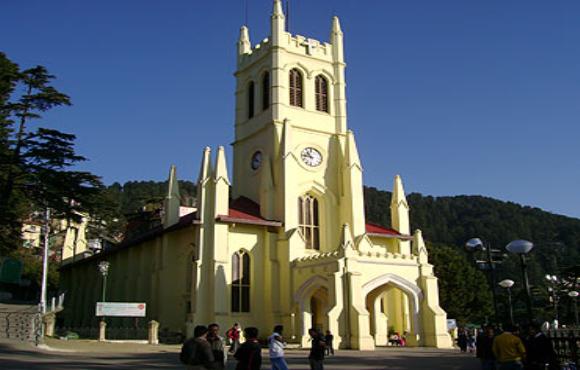Shimla Travel Guide:

Introduction
Shimla formerly known as Simla, is the capital city of Himachal Pradesh. In 1864, Shimla was declared the summer capital of the British Raj in India. A popular tourist destination, Shimla is often referred to as the "Queen of Hills," a term coined by the British. Located in the north-west Himalayas at an average altitude of 2,205 metres (7,234 ft), the city of Shimla, draped in forests of pine, rhododendron, and oak, experiences pleasant summers and cold, snowy winters. The city is famous for its buildings styled in tudorbethan and neo-gothic architecture dating from the colonial era. Shimla is connected to the city of Kalka by one of the longest narrow gauge railway routes still operating in India, the Kalka-Shimla Railway. Shimla is approximately 115 km (71.4 miles) from Chandigarh, the nearest major city, and 365 km (226.8 miles) from New Delhi, the national capital. The city is named after the goddess Shyamala Devi, an incarnation of the Hindu Goddess Kali.
History
Shimla was annexed by the British in 1819 after the Gurkha War. At that time it was known for the temple of Hindu Goddess Shyamala Devi. The Scottish civil servant Charles Pratt Kennedy built the first British summer home in the town in 1822.
Lord Amherst, the Governor-General of Bengal from 1823 to 1828, set up a summer camp here in 1827, when there was only one cottage in the town, and only 'half a dozen' when he left that year. There were more than a hundred within ten years.
Shimla, or Simla as it was called until recently, caught the eye of Lord William Bentinck, the Governor-General of Bengal from 1828 (later of India, when the title was created in 1833) to 1835. In a letter to Colonel Churchill in 1832 he wrote
Climate
Shimla features a subtropical highland climate under the Koppen climate classification. The climate in Shimla is predominantly cool during winters, and moderately warm during summers. The temperatures range from -4 °C (24.8 °F) to 31 °C (87.8 °F) over the year.[19] The average temperature during summer is between 19 °C and 28 °C, and between -1 °C and 10 °C in winter. Monthly precipitation varies between 24 mm in November to 415 mm in July. It is typically around 45 mm per month during winter and spring and around 115 mm in June as the monsoon approaches. The average total annual precipitation is 1520 mm (62 inches). Snowfall in the region, which historically has taken place in the month of December, has lately (over the last fifteen years) been happening in January or early February every year
Culture
The people of Shimla are informally called Shimlaites. With largely cosmopolitan crowds, a variety of festivals are celebrated here. The Shimla Summer Festival, held every year during peak tourist season,[33] and lasting 3–4 days, is celebrated on the ridge. The highlights of this event include performances by popular singers from all over the country.[34] Shimla has a number of places to visit. Local hangouts like the mall road and ridge are in the heart of the city. Most of the heritage buildings in the city are preserved in their original tudorbethan architecture. The Viceregal lodge which houses the Indian Institute of Advanced Study, and Wildflower hall that is now a luxury hotel are some of the famous ones. A collection of paintings, jewellery and textiles of the region can be found at the State Museum (built in 1974). Further out from the city is the Naldehra nine-hole golf course, the oldest of its kind in India.[35] Kufri is a ski resort (winter only) located 19 kilometres (11.8 mi) from the main city. Lakkar Bazaar, a market extending off the ridge, is famous for souvenirs and crafts made of wood. Tatta Pani, 55 kilometres (34.2 mi) from the main city, is the name of hot sulphur springs that are believed to have medicinal value located on the banks of river Satluj. Shimla is also home to Asia's only natural ice skating rink.[36] State and national level competitions are often held at this venue. The Shimla Ice Skating Club, which manages the rink, hosts a carnival every year in January, which includes a fancy dress competition and figure skating events. Due to effects of global warming and increasing urban development in and around Shimla, the number of sessions on ice every winter have been decreasing in the past few years.
The Mall:
The Mall is the main shopping street of Shimla. It also has many restaurants, clubs, banks, bars, Post Offices and tourist offices. The Gaiety Theatre is also situated there. People walk up and down the Mall slowly, stopping to gossip, as it is the main meeting place for everyone. The Ridge and Scandal point are the two main meeting points at the Mall. The mall is dotted with many eating places .The most famous among them is Trishul bakery which is known for its pastries.
Christ Church: Situated on the Ridge, Christ Church is the second oldest church in Northern India. Built with a new gothic architecture, it was consecrated in 1857.
Jakhu Hill: 2 km from Shimla, at a height of 8000 ft, Jakhu Hill is the highest peak and offers a beautiful view of the town and of the snow-covered Himalayas. At the top of the Hill, is an old temple of Lord Hanuman, which is also the home of countless playful monkeys waiting to be fed by all visitors.
Shimla State Museum: The Museum, which was opened in 1974, has tried to protect hill-out and the cultural wealth of the state. There is a collection of miniature Pahari paintings, sculptures, bronzes wood-carvings and also costumes, textiles and jewellery of the region.
Kufri:
16 km from Shimla at a height of 8,600 ft, Kufri is the winter sports capital and also has a small zoo.
Chail
Chail was the summer capital of the Maharaja of Patiala before Independence, known for its cricket pitch, the highest in the world